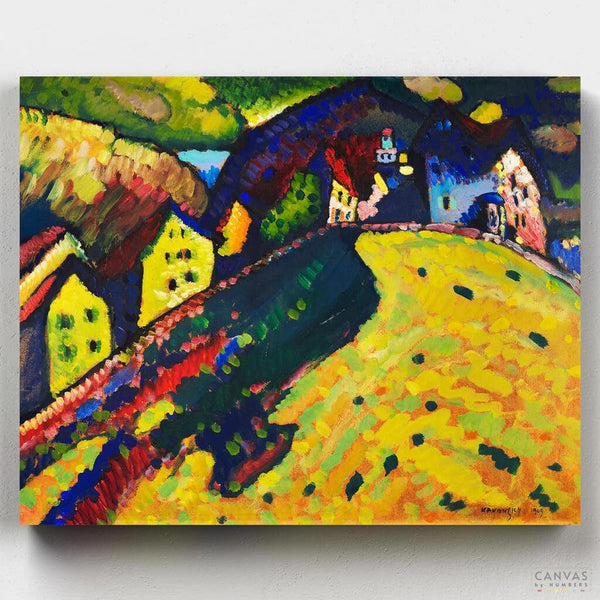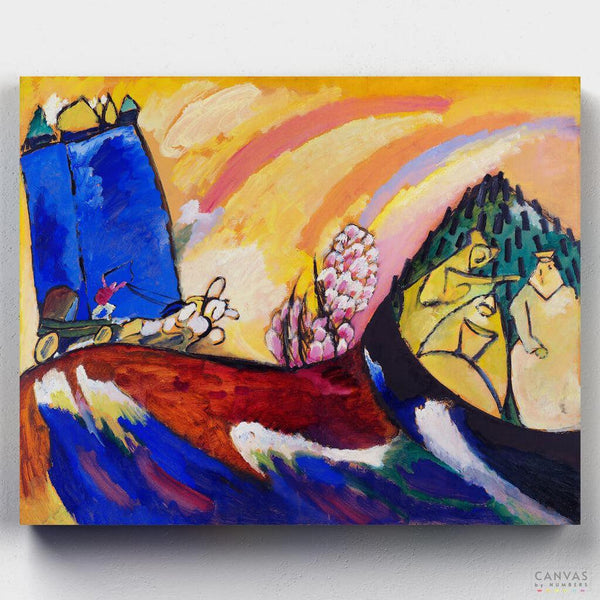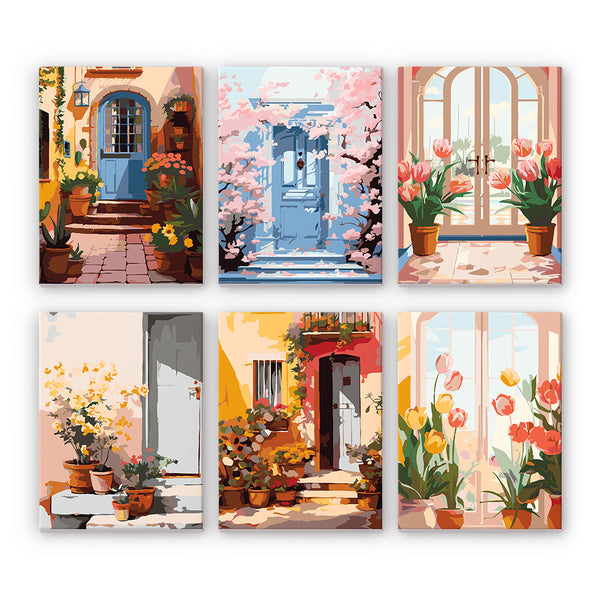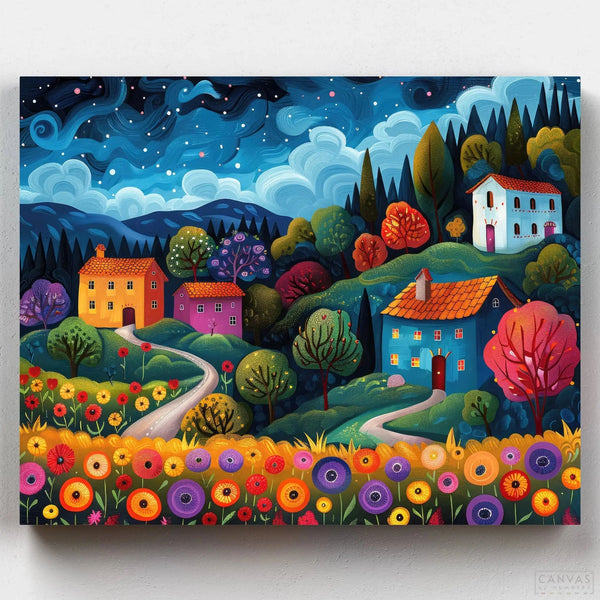Among the most profane in painting, the name Wassily Kandinsky may not be as well-known as Vincent Van Gogh's. However, even if you're one of them, you have surely heard of abstract painting, a form of art where a reality quite distinct from the natural world is represented on the canvas.
For many years, Wassily Kandinsky was mistakenly considered the father of abstract art, a movement that is part of the avant-garde artistic movements. Nevertheless, this error does not diminish the merit of this Russian artist, who became a German and French citizen and gave up a future in teaching to dedicate himself to his true passion: painting.
Wassily Kandinsky: Russia, Germany, and France
Kandinsky was born into a Russian upper-middle-class family, and his childhood and youth were split between Moscow and Odessa.
Although he is now recognized as one of the foremost exponents of abstract art, in 1886 he began studying Law and Economics at the University of Moscow, an area that had nothing to do with painting.
However, in 1896, his natural inclination towards art led him to give up a teaching position at the University of Tartu (Estonia) to focus on painting. This decision was heavily influenced by an exhibition that took place in Moscow at the time, where he could witness, among others, the Impressionist works of Claude Monet.
After resigning from his teaching position, Kandinsky moved to Munich with the intention of entering the Academy of Art. He didn't succeed at first, so for a while, he was self-taught until he was admitted in the year 1900.
In 1911, already a clearly abstract painter (forgive the oxymoron), he co-founded with Franz Marc the Blue Rider (Der Blaue Reiter), a group of German expressionist painters that organized several exhibitions in Munich and Berlin. Unfortunately, the outbreak of World War I in 1914 dissolved the group as several of its members died on the front lines during the conflict.
Kandinsky, who had better luck than his comrades, returned to Moscow when the war started, although his artistic ideas, which were not very sympathetic to Soviet argumentative materialism, led him back to Germany in 1922, to Weimar, where he dedicated himself to teaching at the Bauhaus School until 1933.
Finally, the rise of National Socialism and the pressure of censorship made Kandinsky leave Germany to settle on the outskirts of Paris (Neuilly-sur-Seine), where he would later pass away in 1944.
Abstract Art and Wassily Kandinsky
From the beginning of his artistic career, Kandinsky felt a special attraction to color. His early works show Impressionist and Fauvist traits, but through constant experimentation, he fully embraced abstraction in 1910.
Kandinsky himself acknowledged that nature is inherently unbeatable, so it's not worth creating a crude imitation of it. According to his artistic theory, painting should focus on expressing emotions and ideas through chromatic richness and simplification of forms, with the object being something secondary and even dispensable in the artwork.
In addition to color, Slavic decorative elements and geometric shapes were very important in his abstract works, especially angles, straight lines, semicircles, and circles.
As mentioned at the beginning of this post, he was considered the father of abstract art for a long time due to the publication in 1911 of the book "Concerning the Spiritual in Art," where he founded the theory of the abstract movement and defined a new form of art.
However, it has been shown that other artists created abstract works towards the end of the 19th century, such as the Swedish painter Hilma af Klint, who painted abstract pictures five years before Kandinsky's book was published. The reason why these works were not discovered earlier is that the artist never participated in exhibitions and in her will expressed her wish for her paintings not to be shown to the public until at least twenty years after her death (1944).
Regardless, the thinking of the Russian-German-French painter marked a turning point in the history of art and laid the artistic foundations that would inspire other renowned painters like Dalí, Miró, and Pollock.
Famous Paintings by Wassily Kandinsky
Houses in Murnau (1909)
Although this artwork dates back to the time when Kandinsky was beginning to fully embrace abstraction, it is part of his expressionist paintings. The intensity of color, a distinctive feature of the painter, can be seen in the yellow and blue tones of the painting, and the distortion of lines reflects the detachment from reality.

Painting with Troika (1911)
The brushstrokes in this expressionist painting also give a sense of movement to the composition. From left to right, we can observe different human forms: a rider on a carriage pulled by horses (the troika) and a group of soldiers in front of what appears to be a hill filled with tombstones.
What did Kandinsky intend to represent with this painting? Possibly, the looming presence of World War I, a result of the tensions between European powers.

Composition IV (1911)
Composition IV, one of the most famous painting in art history, is a painting that lies somewhere between expressionism and abstract art, and possesses the synesthetic quality cherished by Kandinsky: the connection between music and painting through the association of sounds with colors and moods. What does this well-known artwork suggest to you?

How to Paint a Kandinsky Painting?
At this point, when discussing Kandinsky and abstract art, we propose that you free yourself from the notion that you don't know how to paint a picture.
Perhaps you have tried it before but simply lacked the right method. By "method," we mean a guide or technique that allows you to faithfully reproduce one of the works by the Russian painter. All for the satisfaction of realizing that you have truly painted it with your own hands, in addition to enjoying a relaxing activity (and one more affordable than a weekend getaway).
That method is the paint-by-numbers for adults offered by Canvas by Numbers, a technique that involves dividing the canvas into numbered areas and applying the corresponding color to each one. This way, you can paint the artwork even if you have no prior experience with brushes.
What Will You Receive to Paint at Home?
With your order, you will receive everything you need to create a work of art:
- A numbered and blank canvas with the Kandinsky painting you have chosen to paint.
- A photograph of the finished artwork as a guide.
- A set of harmless acrylic paints.
- Brushes of various sizes.
- Instructions for painting the artwork by following the numbered areas on the canvas.
In essence, all you need to contribute is the willingness to explore your artistic side, enjoy the process, and proudly display the final result.
Choose the Kandinsky painting you would like to paint here and let's get started! You can also find some of their works in our Diamond Paintings collection.

















